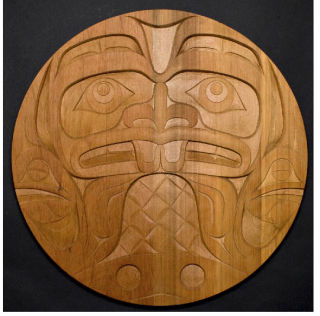For thousands of years before the Spaniards first saw the San Juans in 1791, the islands were the home of Coast Salish peoples and a culture that was intertwined with the natural beauty and resources offered by the archipelago.
“The people of the San Juan Islands should remember that people have been living there for thousands of years,” Burke Museum director Julie Stein said in an earlier interview. “You are just the most recent people who have lived there.”
Coast Salish peoples were forced to move to reservations, but their cultures and ties to the islands — and those of other Northwest Coast Native peoples — survive. And in the next few weeks, several events will take place that will help San Juan residents connect with the original cultures of the islands.
The first event begins Saturday: the opening of Arctic Raven Gallery’s “Transcending Form” exhibit, which spotlights the diversity and richness of Kwaguilth artist Rande Cook’s contemporary vision. Other artists expected at the opening include Mervyn Child, Kwakwaka’wakw; Calvin Hunt, Kwaguilth; and John Livingston, Kwakwaka’wakw.
Cook, 30, apprenticed with master carver Hunt, He now shares a carving shed with Livingston, his mentor.
In this, his first solo exhibit, Cook masters the melding of traditional Northwest Coast Native design with the modern. Among the works on exhibit: “Urban Tradition,” a sculpture whose tall, carved cedar columns mimic high-rise buildings. Metaphorically, the sculpture connects past and present, reminding the viewer that Native longhouses once lined shores now covered with skyscrapers.
Other works in cedar and glass — abstract panes, bentwood boxes, chests, paintings and paddles — reflect Cook’s infallible graphic design sense.
With dimples and a mop of curly dark hair, the youthful Cook shows an unbridled enthusiasm for the creative process. Designing on paper is a compulsion; he doodles unconsciously as he does other things.
“He drew a cool raven on the note pad on my desk during a phone call,” Arctic Raven owner Lee Brooks said. “Rande doesn’t hang onto to these sketches. His motto is, ‘Expression in the Moment.’ Fresh and unique ideas are constantly flowing from him.”
Cook received his grandfather’s chieftainship at a potlatch at Alert Bay, B.C. in February. “With that honor comes the cultural responsibility of making sure children receive their Native names, along with appropriate songs and dances,” Cook said in a press release. “Despite the hard work, in the end I am rewarded with a sense of continuity and rebirth. Our children are our future.”
Family is the only thing that comes before Cook’s artistic calling and he displays the importance of his heritage in his art, constantly astonishing his elders with the sophistication and conceptual creativity of his work. The show “is about the journey from the past to the present,” he said, “The lead piece is a ‘Box of Treasures’ because everything came out of the original box in our creation story.”
This exhibit is free and continues through July 27.
The Lummi Arts Festival is July 19-20, with events planned in three locations: The gallery on the corner of West and First streets, Dance Workshop II on Second Street, and the San Juan Historical Museum. The events are free and open to the public.
Friday Harbor House has donated the use of the former gallery on West and First streets for an exhibit of works by artists from the Lummi Nation and from Turtle Mountain Chippewa. The range of artwork includes beadwork, carving in wood and bone, cedar masks, cedar baskets and cedar clothing, graphic arts, leatherwork, mixed media, photographic arts, quilting, sculpture, silverwork, and willow baskets.
Lummi artists: Shasta Cano-Martin, music and poetry; Yvonne-Thomas Miller, mixed media/painting; Ernestine Gensaw, cedar baskets and weaving/clothing; Earline Hansen, beadwork; Chrystal Jack, beadwork; Charles Miller, carving (masks); Mike Peters, graphic arts; Bruce Pierre, graphic arts/mixed media; Maxine Stremler, photography; Mike Thomas, carving (wood and bone); Lawrence Tom, graphic arts; and Clarissa Young, beadwork.
Turtle Mountain Chippewa artists: Alfred DeCoteau, stone and wood sculpture; Larry DeCoteau, painting and sculpture. Pati Kippen, ceramic/leather vases; Marcellino Parisien, sculpture; Sandra Parisien, beadwork and silversmith; Maureen Williams, quilting.
A performance arts event is scheduled July 18, 6:30-8 p.m., in Dance Workshop II. Two presentations are planned July 19, 6:30-8 p.m., at San Juan Historical Museum, 405 Price St.: “These Ancestral Islands: Oral History of the San Juan Islands,” and “Cultural Lifeways of the Turtle Mountain Reservation.”
Lummi, Nooksack, Samish and Swinomish canoes arrive in the San Juans en route to Duncan, B.C., as part of the 2008 Canoe Journey. Canoes will stop at Shaw Island on July 24 and Roche Harbor on July 25.
The Canoe Journey is a cultural connection like no other: With the cedar, which for millennia has provided material for art, canoes, clothing, fishing nets and houses; with the water, the marine highway for coastal peoples since time immemorial; and with extended families across the Northwest Coast. It’s also an intense athletic event; some canoes travel for hundreds of miles to get to the final destination, and each puller has to be mentally, physically and spiritually disciplined.
At each stop along the Canoe Journey, the public can watch the colorful, soulful arrival of the canoes: Colorful, because each canoe and paddle is an elaborately carved work of art; and soulful, because many of the canoe families keep time to songs, which often come to them on the water. On the shore, in keeping with tradition, canoe families ask permission — often in their own languages — to enter and leave each territory. This event, known as protocol, is moving for participants as well as observers.
There will be a free community welcome dinner on July 25, 7 p.m. at Roche Harbor to welcome the canoe families. Volunteers are needed; call Stephanie Buffum-Field of Friends of the San Juans, 378-2319.
The Canoe Journey ends in the territory of the Cowichan First Nation, which also hosts the 2008 North American Indigenous Games.
— With writing by Talia Loucks, intern, and Richard Walker, editor.




